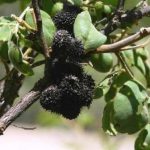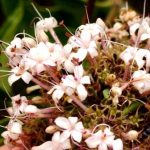TREE LIFE
July 2005
MASHONALAND CALENDAR
Saturday 2nd July: Botanic Garden Walk. Subject ‘This and That’ Meet Tom in the car park at 10.45 for 11 a.m.
Sunday 17th July.
Sunday 17th July: Because of the fuel crisis, please phone Mark or Maureen to confirm that this trip is still on.
An all day visit to Blackfordby in the Concession area. Meet at the lecture halls at 9.30 a.m. There may be milk available to buy at about 3 o’clock in the afternoon. Bring your own 2 lt container. The milk is fresh from the cow and is not pasteurized! At present it is $4500 per litre but it may well have gone up by then. There may be eggs and tomatoes for sale as well, so you will need some cash. Bring your lunch and a chair for an all-day outing.
Saturday 30th July: Mark’s walk this month (the 5th Saturday in July) will be at St. Georges College. Meet in the car park near the squash courts at 2.30 p.m.
Saturday 6th August: Botanic Garden Walk.
MATABELELAND CALENDAR.
Please contact Jean Wiley or Gill Short for details of the next Matabeleland function.
A TREELESS OUTING. February 2005
Mt Rukotso and World’s View may seem unusual destinations for an outing of the Zimbabwe Tree Society. Apart from the occasional Pine or Wattle infestations, trees are conspicuously absent from these areas, dominated by rocky montane grassland and wet seepage zones. This, however, was to be a Tree Society outing with a twist: the participants were not intending to look for trees, but for orchids. February is the peak period for terrestrial orchids to flower in vleis and montane grasslands, which made these locations an ideal target. Nine members had decided that, trees-or-no-trees, it was good to get away and breath the healthy, cool, mountain air. They were not disappointed; our accommodation at Ezulwini was excellent, the weather was mostly splendid – if you didn’t mind a stiff breeze – and the bounty was good. In the expert company of Werner Fibeck, nearly 30 orchid species were found, admired, debated and photographed.
The target on the first day was Mt Rukotso. Its habitat is very similar to that of Mt Nyangani but, at 2407 m, it is somewhat lower and it is definitely a lot more easily accessible. A rather bumpy dirt road leads almost to the summit, where a tall radio beacon helps to keep us all connected and informed. Although much of the lower slopes are being used for the cultivation of potatoes, the higher parts still offer a mostly undisturbed mixture of montane grassland, rock crevices and boggy seepage zones.
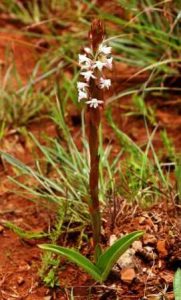
Satyrium longicauda. Photo: Bart Wursten. Source: Flora of Zimbabwe
We did not have to wait until we got to the top before we saw the first orchids. Satyrium longicauda, its dense, erect spikes of white flowers flushed with pink, was commonly seen along the roadside. It is what Werner calls a typical generaliser. Most terrestrial orchids are very particular about their habitat requirements and any disturbance, such as cattle grazing or potato growing, will cause their disappearance. S. longicauda is not so fussy and, although you won’t see it poking its pretty head out of a fresh field of spuds, it is definitely one of the first orchids to appear in places that are ready to be re-colonised by nature.
Satyrium is a genus of terrestrials, mainly from temperate and montane areas in Africa, with a few species found in Madagascar and Asia. Zimbabwe has 21 species on the list, some of which we’ll meet later. Members of this genus are recognized by the presence of 2 spurs. These spurs are borne on the hood of the flower and this hood is actually formed by the lip. This is a second characteristic of Satyrium. In most orchids the lip is at the lower end of the flower, functioning as an attractive landing platform for the pollinator and, if they have a hood, it is formed by the dorsal sepal, which may or may not be joined with the petals. It might seem that flowers of Satyrium are upside-down but in actual fact all those other orchids are. When the flowers open, the stalks twist over 180° to achieve the right position. This phenomenon is called resupination and therefore Satyrium is one of the few genera which is non-resupinate.
We stopped at a few places, where water was seeping over the rocks, soaking the short grasses and mosses. These areas turned out to be particularly rich in orchids. Two species of the genus Habenaria were very common in these places. H. macrostele is a slender plant with many small green flowers. They seemed hardly noticeable at first among the grasses but we soon started to pick them out and they were everywhere in this habitat. H. subaequalis was more easily spotted. The flowers are larger and mostly white and it prefers to grow in very shallow soil on the wet rocks. This species, common in the right places, has a very restricted distribution and is endemic to the Eastern Highlands of Zimbabwe and a few similar places on the Central Watershed.
Habenaria is a large pan-tropical genus. No less than 61 species are found in Zimbabwe alone. The majority have green flowers and, at first sight, seem inconspicuous and rather dull. On closer inspection, however, they turn out to be the most amazingly intricate plants, which could very well form the inspiration for the alien creatures we see in Sci-fi movies. The spidery flowers appear to be made up of a lot more parts than other orchids. The petals are split into 2 lobes, which are sometimes hinged so they move independently at the slightest touch; the lip is split into 3; the spur often curled or twisted; and the fertile centre, called the column, often has knob-like bits sticking out as if it is looking at you with eyes on stalks. Next time you think you see a Habenaria, make sure it doesn’t take off in a UFO!
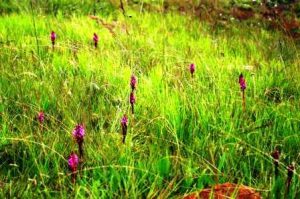
Disa versicolor. Photo: Bart Wursten. Source: Flora of Zimbabwe
Another common orchid in this habitat was Disa versicolor. The dense, candle-like inflorescences of small, deep purple-pink flowers made a striking contrast with the grasses and dark rocks. The large leaf-like bracts between the flowers often blacken and dry up during the flowering time, giving the plants a burnt appearance. D. versicolor only has small, sheathing leaves enveloping the stem. The actual foliage leaves appear next to the flowering stem on a separate sterile shoot. This feature is known from several species of Disa, as well as Satyrium. It may sometimes help to distinguish two closely related and similar species.
The genus Disa is almost entirely African, with the highest concentration of species in the South African Cape. Zimbabwe has 21 species. Most of these are restricted to montane grasslands, bogs and vleis in the Eastern Highlands. Many older records exist from other parts of the country but there, with the destruction of their particular habitats, the orchids have vanished. Species of Disa may look superficially similar to Satyrium but are easily distinguished by having only one spur coming from the hood, which is formed by the joined petals and dorsal sepal. Disa species also have a small but distinct lip.
Two more species of Disa were seen that day. First, we found Disa patula subsp. transvaalensis in a nearby patch of drier montane grassland. This is a more robust species with a more open inflorescence and larger flowers in a beautiful lilac-pink, the lateral sepals often spotted in a darker purple. Again, it has the foliage leaves on a different shoot. When we stopped at an area of big rocks and boulders, we found Disa saxicola. This is a slender and very elegant member of the genus. The flowers are white to pale pink with darker spots. The stalks and stem are coloured a much deeper purple. This species has a tuft of dark green leaves at the base of the flowering stem.
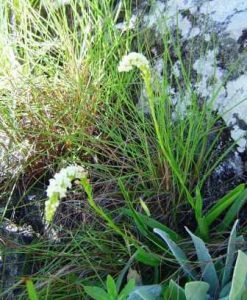
Schizochilus cecilii subsp. cecilii. Photo: Bart Wursten. Source: Flora of Zimbabwe
When we finally reached the plateau near the summit, the weather had changed a bit. It was still fairly sunny but the wind had reached gale proportions. We decided to have our lunch inside the vehicles and avoid losing our sandwiches to the storm. It was obviously not going to get any better, so, after lunch we held on to our hats and scrambled up the rocky ridges to look for more orchids. Our efforts were well rewarded with Disa saxicola and patches of Schizochilus cecilii subsp. cecilii. This is another endemic in Zimbabwe, only found at high altitudes in the greater Nyanga area, where it favours the shallow soils overlying rocks. This delicate species has a typically drooping inflorescence of tightly compacted, small white or yellow flowers. Nearby we found another two Satyrium species. A lively debate on their proper identities was to provide most of the entertainment during the candle-lit evening back at Ezulwini. All the assembled knowledge and literature failed to give us an entirely satisfactory answer but it was provisionally decided that the smaller species with yellow flowers and fleshy, mostly basal leaves was probably S. chlorocorys. The other plant, a much stouter species with a dense candle of yellow flowers, leaf-like bracts and large leaves on the lower stem, was thought to be S. volkensii. One of the problems was that, in the various books, the key to their separation dealt with rather ambiguous details, while the species were clearly different in the field. Unfortunately the lack of photos didn’t help our cause.
One more interesting species was found close to the summit. Cynorkis anisoloba belongs to a small genus of terrestrials, which are distinctly covered in glandular hairs. Five species are known to Zimbabwe and C. anisoloba is another endemic. It is fairly widespread throughout the Eastern Highlands but is said to be always rare.
-Bart Wursten To be continued.
ANNUAL GENERAL MEETING MAY 15, 2005:
Our A.G.M. this year was held at a Meikles property in Borrowdale, arranged through Terry Fallon and the Masons, who live on and manage the property. The A.G.M. was held on the lawn of the Mason’s house in the comfortable shade of some trees. The A.G.M. itself went well – there is always a slight feeling of relief afterwards that no awkward questions were asked!
After the meeting we set out as a group to look at the trees on the plot. One of the surprising things was the sheer size of it – right in the middle of Borrowdale. I certainly was not aware of its existence. Through the middle runs a stream and that is surrounded by mainly grassland with a few trees. Back gardens of residential housing abut the area and as at Greystone Park Nature Reserve which is similar, the area has been highly invaded by species from gardens. However, we started with two good native trees. Acacia sieberiana is a common tree around Harare. Next to the Mason’s house was a nice specimen, showing the papery pale bark in the upper branches, the tiny numerous leaflets and the fattish pods. Nearby was a small Albizia harveyi. The identification of this was greatly assisted by the presence of a label – which I imagine implies that the species came from a nursery and hence was planted. However, A. harveyi is a possible species, even at as a high an altitude as Harare.
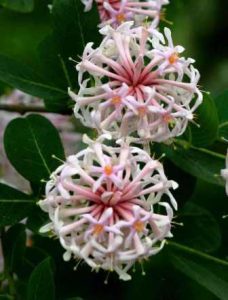
Dais cotinifolia. Photo: Bart Wursten. Source: Flora of Zimbabwe
Another tree often planted in gardens around Harare is Dais cotinifolia – the Pompom tree. I think it must be a rather local species in the wild – it occurs in the Eastern Highlands – but there is no doubt that it does well around Harare and is a very pretty species. It belongs to the family Thymelaeaceae, a small and not very well known family with us, but one that is widespread throughout the world. Probably the commonest member of the family we see is the suffrutex Gnidia kraussiana, which comes up in spring, often in burnt areas and has yellow-flowered umbellate inflorescences.
Here too were Homalanthus populifolius (the Queensland Poplar) and Toona ciliata (cedrela). Both frequently escape around Harare, particularly the Toona. This is not quite so successful a weed, but does better in the Eastern Highlands. Another successful invader is the Grey poplar, Populus × canescens, which fills vleis and stream beds with many tall, unbranched, spindly suckers and is thereafter very difficult to eradicate.
In fact, many of the plants seen on the walk were exotics and escapes. We walked through the open grassland, admiring the horses, and crossed the stream by a small bridge and headed down the other side of the valley. Here were naturalised jacarandas showing their characteristic pale yellow leaves at this season.
Another frequent escapee around Harare is a species of Fraxinus, believed to be Fraxinus americanus (the American ash). This has opposite compound leaves and when not in flower or fruit could be confused with a species of Bignoniaceae – e.g. Stereospermum kunthianum, the Purple jacaranda.
Here, too, were plants of the spectacularly successful exotic Prunus cerasoides, the Himalayan flowering cherry. This has a distinctive bark with transverse peeling rings, very noticeable in larger trees. Some of the trees were actually flowering, showing the pink flowers that appear in autumn.
On we walked: Guava, Lantana, privet, Rubus – all the common weedy plants that you see around Harare. Macfadyena unguis-cati was there, surging up the walls of a small hut and up the trunks of trees. Not a very noticeable plant when it is not flowering, it has got a very good hold on the Harare area nowadays.
As we reached the far end, we came across some planted Honey locust trees, Gleditsia triacanthos. Although it is not really part of the flora (there is one record of it naturalised) it is nevertheless an extraordinary species. The “triacanthos” part refers to three spines and these were very noticeable on the branches; there is a principal spine bearing two secondary spines; the latter were sometimes absent and then the whole structure was reduced to a single spine.
Another extraordinary feature of Gleditsia is that it has BOTH 1-pinnate and 2-pinnate leaves on the same plant. We were able to examine this on the trees we saw.
From there we returned back to the lawn for lunch. In the afternoon, there was a general departure but a few of us walked on the other side of the property where there was an interesting range of exotic oaks (Quercus species).
I would like to than the Masons for hosting us and Terry for making the arrangements.
-Mark Hyde
BOTANIC GARDEN WALK: 7 MAY 2005
The subject today was part 2 of the family Celastraceae. In addition to wrapping up the family, we also looked at one or two other unrelated species of interest.
The first species we looked at was a Salacia. I must confess that I have never seen a Salacia in the wild and indeed they do not occur in our favourite haunts on the highveld around Harare, but are generally only to be found at low to medium altitudes in the SE of the country. This particular species was collected by Tom in “one of the funny little forest remnants towards Ratelshoek estate” and the species is frequent in the forest areas at Haroni-Rusitu.
It is a climbing woody plant with hanging branches and opposite leaves and was initially thought to be a species of Hippocratea. However, it was eventually found to have berries for fruits – Hippocratea spp. have the extraordinary flattened capsular fruits which are arranged in whorls of 3. Like most capsules, they are dry and contain winged seeds.
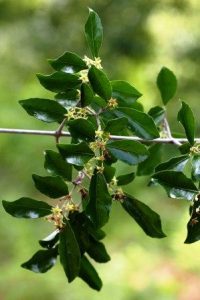
Hippocratea crenata. Photo: Bart Wursten. Source: Flora of Zimbabwe
Shortly afterwards, we came across a Hippocratea, namely Hippocratea crenata, and this was actually bearing the characteristic triads of fruits. It was also in flower and we were able to examine the tiny yellowish flowers. H. crenata can be distinguished from other Hippocratea spp. by its small leaves which are markedly and clearly crenate and also glossy.
Hippocratea spp. are climbers and have opposite leaves and opposite branches. Very often the apex of the stems is more or less leafless with bare whippy branches seeking supporting objects to climb. A good example of that was Hippocratea longepetiolata which we saw in the gardens. Also nearby was Hippocratea parvifolia, which also has distinctive horizontal side branches forming an aid to climbing. This is a species of riverine habitats and also occurs in the jesse.
Another rather unusual species seen was Gymnosporia (formerly Maytenus) tenuispina. This is a species of mopane woodland and has been collected once in the Beitbridge district by Denzil Carr. The plant was certainly well armed with numerous alternate and opposite spines.
As a small digression, we noticed that the Bindura Bamboo (Oxytenanthera abyssinica) was in full spectacular flower. Tom informed us that the specimens were planted 40 years ago and this is the first time that they have flowered en masse in this way. It is likely that having flowered, all the plants will die and (hopefully) spring up again from the seeds. This mass flowering is characteristics of certain types of bamboo but not all do it. It will be interesting to see what happens in this case.
On next to the genus Cassine. Like Hippocratea, the generic splitters have been at work here too and in some cases this marks a return to earlier concepts. Elaeodendron matabelicum (Cassine matabelica) occurs in granite hills in savanna woodland. It is widespread but not always common. Tom mentioned that it is not particularly a Matabeleland species, despite the specific name.
Mystroxylon aethiopicum (Cassine aethiopica) is a common species of middle altitudes, most often found in riverine habitats, sometimes also in rain forest and occasionally in shady places such as termite mounds. It is recognisable by its ovate leaves with pale veins. The fruits are small and red.
Eleaodendron transvaalense (Cassine transvaalensis) has a narrower leaf which is often deeply toothed. It occurs quite commonly on anthills. The trunk is often pale.
Maytenus undata is still a Maytenus and has not a Gymnosporia as it is a non-spiny species. This is common around Harare, often in the moist parts of granite kopjes and also in riverine vegetation. The leaves have a waxy coating so that when they are folded in half and unfolded a broad grey line is visible along the fold.
Once again, our thanks go to Tom for another fascinating view of Zimbabwe’s trees.
-Mark Hyde
THE PETHERAM FILES Continued…..
The Forgotten Tree Planter
The following is reproduced, with some editing, from the Cabbages and Kings column of The Rhodesia Herald of 19 March 1974.
In 1898 Cecil John Rhodes told Ernest Montagu that he was going to Mashonaland. This was the first that Montagu had heard about it, but Rhodes was like that. Rhodes told Montagu this on the steps of the Kimberley Club, an establishment where he seems to have made many of his decisions.
Ernest Montagu started as a clerk in the Mines Department at a salary of £480 a year, and eventually became Secretary for Mines, then Secretary for Roads and Public Works.
He retired in 1923 after serving with the British South Africa Company’s Administration for 25 years. And for most of that time, and for many years afterwards, he was the very active Chairman of the Tree Planting Committee in the then Salisbury. He was knighted for his services to the country and its capital city, and was still on the Tree Planting Committee in 1945.
When Sir Ernest retired from the British South Africa Company, a banquet was held in his honour at Meikles Hotel, and the then Deputy Mayor, J Reid-Rowland, said, “Sir Ernest has been Chairman of the Tree Planting Committee for many years, and devoted a large amount of spare time to that work.”
“In the early mornings and late afternoons he could be seen wandering the streets instructing employees on the work. The town in years to come will be very grateful—and in a few years will be very beautiful.”
How right he was. It would seem that if any one person could be said to be responsible for Salisbury being able to claim the title “City of Flowering Trees”, it was Sir Ernest, (and isn’t it sad that this title seems to have been rejected in favour of the slicker, but less accurate “Sunshine City”). Incidentally, Sir Ernest was still on the Tree Planting Committee when the City’s former Amenities Manager, Ronnie James, joined the Municipality. And while Ronnie was still a new boy, Sir Ernest gave him hell for stopping the staff washing the termites off the trees. “In five years there won’t be a single tree left in Salisbury”, said Sir Ernest.
But it was a never-ending job—by the time the termites had been washed off the last tree, they had again got a good hold on the first one. In any case, Ronnie James believed, and says it has been proved, that termites do established trees more good than harm. “They only attack the old bark”, he says. “They replace it with their mud covering, which protects the young bark underneath until the rains come and wash off the ant dirt”.
[Comment 2002: Cape Avenue in Salisbury was renamed Montagu Avenue in recognition of Sir Ernest’s service to the capital city. Shortly after Zimbabwe’s independence, however, there was another name change, and Montagu Avenue became Josiah Chinamano Avenue. So there is now no longer any memorial to the man who worked so hard to beautify Harare’s streets and avenues. He is simply the forgotten tree planter.]File 7. This and That
This is the last of Dick Petheram’s files—actually a combination of three files containing miscellaneous information, much of it not directly connected with trees.
Randolph Nesbitt’s Golden Cypress
Randolph Cosby Nesbitt, (1857-1956), VC hero of the Mazoe Patrol during the Shona uprising of 1896/97, appears to have been both Member in Charge of the Police and Native Commissioner at Goromonzi in the first and second decades of the 20th century. A letter to Dick Petheram written in 1975 by Nesbitt’s niece, Mrs Nora Jack, says “at first Uncle Randolph did Police and Native Department, he used to ride up to the Police Camp in the morning…and then in the afternoon he went up to the Native Department…” According to Mrs Jack, Nesbitt was based at Goromonzi for about 25 years, and Joy Maclean (1974), The Guardians, has him as Native Commissioner, Goromonzi, in 1920, about six years before he retired to live in South Africa.
During his time at Goromonzi Nesbitt planted a golden cypress in the garden of the Native Commissioner’s house, some time between 1901 and 1907, and in 1975 the then District Commissioner confirmed in a letter to Dick Petheram that the tree was still there. It was probably Chamaecyparis lawsoniana (Lawson’s cypress)—possibly, but less likely C. obtusa (Hinoki cypress). Either way, it would have been among the first of its kind planted in Zimbabwe. We have a definite record of the introduction of C. lawsoniana in 1907, but the date of introduction of C. obtusa is obscure.
Dick Petheram tried to get National Museums and Monuments to place a plaque at the tree, and although this was agreed in principle, there is no definite evidence in the files to show that anything was actually done.
Zeedeberg’s Staging Post at Filabusi
A similar attempt was made by Dick Petheram to have a plaque erected at a Combretum imberbe in Filabusi that was used as a staging post for the Zeedeberg coaches during the last years of the 19th century and the very early years of the 20th. Again, there is no definite evidence in the files that any plaque actually was placed at the tree.
–Lyn Mullin To be continued
HISTORIC TREES OF ZIMBABWE By LYN MULLIN.
Copies of this wonderful book are still available from Maureen Silva-Jones.
Telephone. Home 740479; Work 757171 (Harare)
Soft Cover – $150 000.00
Hard Cover – $225 000.00
Leather Bound – $300 000.00
MARK HYDE CHAIRMAN


